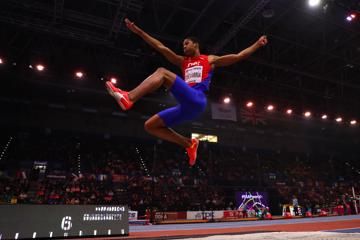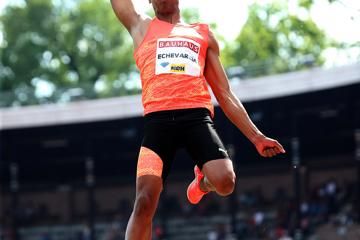Juan Miguel Echevarria after winning the long jump at the IAAF Diamond League meeting in Stockholm (© AFP / Getty Images)
In the beginning, it looked just like any other jump.
It was late afternoon at the Olympic Stadium in Stockholm, midway through the IAAF Diamond League meeting on Sunday, when the old, ornate arena welcomed the arrival of a new sensation.
Juan Miguel Echevarria looked down at the track and let out a shout, puffed his cheeks, then lifted his head and stared down the runway one final time – a jet plane cleared for take-off.
He waved his right hand in front of him in an angry upward swipe to mimic his future trajectory, then bobbed up and down in a one-two skip before finally breaking into stride.
His first couple of steps are relaxed, then Echevarria cranks up the force, building momentum with each passing step. Until the last two strides, his body is upright, but then he lowers his centre of gravity, as if about to take a seat in an imaginary chair, shortly before lift-off.
His last step, the one that takes him on to the board, is a long one, and as he plants his right foot Echevarria’s vision is tilted skyward, the direction he’s about to go.
It’s at this point those watching realise this is not just any other jump, but one in which Echevarria is achieving a kind of technical nirvana, one where angles and force and speed and timing have all aligned in blissful unison.
In the stands nearby, Echevarria’s coach Daniel Osorio stands at the very front. Afterwards, he can recall being struck by a single thought after his protege hit the board.
“He’s flying.”
Building a champion
Ten years – that’s how long this performance was in the making.
To soar 8.83m through the air, the longest jump in the world in any conditions for 23 years, Juan Miguel Echevarria had to put in 500-odd weeks of training and pass through multiple coaches, who each added their own splash of paint to what he has become – a long-jumping masterpiece.
Echevarria first took up athletics at Ernesto Lucas elementary school in his hometown of Camaguey, and credits the influence of coaches Tomas Hernandez and Ivan Izaguirre for his early development. After showing promise at a range of events, he was selected to join the national youth team in his early teens, where coach Juan Gualberto Napoles took charge.
When it comes to boxers, cigars and world-class jumpers, nowhere produces them quite like Cuba, and from an early age it was clear Echevarria could be the latest champion to emerge from the proud sporting nation.
In 2015, at the age of just 16, he managed his first eight-metre jump, sailing to 8.05m on home turf in Havana. But his major championship debut that summer didn’t go to plan, Echevarria edged out of the medals at the IAAF World U18 Championships in Cali when only jumping 7.69m in the final.
The following year his plans to make the Rio Olympics and do his talent justice at the IAAF World U20 Championships in Bydgoszcz – where he had to make do with fifth – also fell to pieces.
“I suffered an injury to my jumping leg that took me completely out of practice for two months,” he said. “That didn’t allow me to reach the World Juniors in the best way. I practically lost the whole year.”
But with his health restored in 2017, Echevarria came back better than ever, jumping a PB of 8.28m in Madrid last July, then a wind-assisted 8.34m (2.3m/s) two days later in Padua. The IAAF World Championships in London proved another disappointing championship, Echevarria eliminated in the qualification round with a best of 7.86m.
Last September, Osorio took over his coaching duties and as a man who has been in the game for 20 years, he knew he had something special.
“The most talented I ever had,” he says of Echevarrria.
At their training base in Havana, the pair work on the all-encompassing jigsaw that comprises a world-class long jump. “There are many factors that must coincide at one exact moment: the speed of the runway, the technical execution, the psychological state of the athlete,” says Osorio. “We’ve done a lot of work on controlling competition nerves that in previous competitions, whether because of youth or immaturity, he couldn’t master.”
Striking gold
Earlier this year, Echevarria showed the fruits of his labour during a thrilling men’s long jump final at the IAAF World Indoor Championships in Birmingham, where he toppled world champion Luvo Manyonga to take gold.
Leading from the opening round, the Cuban was subsequently twice out-jumped by Manyonga, only to respond in kind on both occasions, showing impressive championship temperament for one so young. His winning jump of 8.46m was a world lead and beat Manyonga by four centimetres.
As he left the frozen landscape of Birmingham that week for the heat of Havana, Echevarria knew a big summer was on the horizon.
In Rome a fortnight ago, he was second best in his rematch with Manyonga despite jumping a PB of 8.53m. Heading to Stockholm last weekend, that kind of mark was all he was thinking about.
“I wanted over 8.50m but I didn’t think I could jump so far [as 8.83m],” he said.
As he sailed through the air on that final leap, his legs hitch-kicking like a windmill beneath him, it was clear that Echevarria was about to go far – perhaps even too far.
He eventually plonked down just inches from the end of the sand pit, the awkwardness of the perimeter sending him backwards upon landing (though Echevarria smartly cranked his body to the side to avoid losing distance).
An anxious, excited minute followed as he waited like a kid on Christmas for the official measurement, and when it flash up on screen Echevarria erupted in celebration, joined on the track by his coach, the two hugging in exultation.
“I expected it was possible because we had worked very hard this year,” said Osorio. “But I just can’t believe it.”
The wind reading (2.1m/s) may have made the mark ineligible for record purposes by the smallest margin, but either way, no one doubted that this was one of the greatest jumps in history.
Inevitably, thoughts soon turned to the world record of 8.95m, set by Mike Powell in 1991.
“It’s possible,” said Osorio. “But our first thing is about technique because technique is very important. Never think first about the result; think first about the technical [elements] because the result is the last thing.”
Crucially, they have in their corner a Cuban who Echevarria grew up idolising, and who now serves as a mentor in his development: Olympic champion Ivan Pedroso.
“He’s my very, very, very good friend, and he helped me with his technique,” said Osorio. “I love Pedroso. He is like my brother.”
With barely time to draw breath after Stockholm, Echevarria will be back on the runway at the IAAF World Challenge meeting in Ostrava on Wednesday evening (13), where his coach believes a repeat performance – or better – could be on the cards.
“I can see that improving,” said Osorio, “because at this moment he doesn’t have limits.”
Mike Powell breaks the world long jump record at the 1991 IAAF World Championships in Tokyo
Echevarria will face Manyonga and Olympic champion Jeff Henderson in Ostrava, while world record-holder Mike Powell and European record-holder Robert Emmiyan will be in attendance as special guests.
Shortly after his Stockholm stunner, Echevarria was asked to name his long-term ambitions, and the teenager didn’t hesitate for a moment before making them public.
“I want to win the Olympic Games,” he said, “and to set a world record.”
Cathal Dennehy for the IAAF






